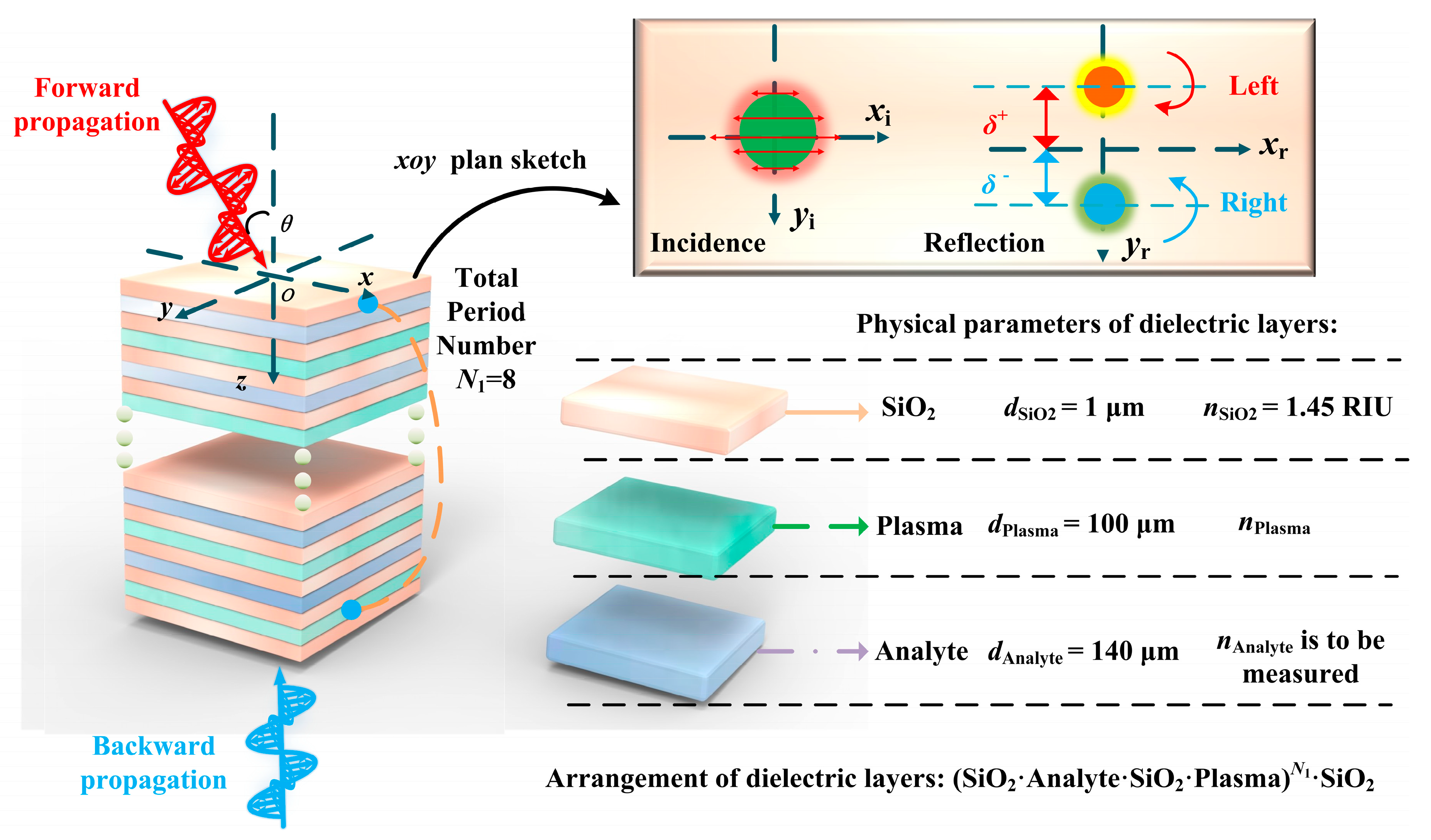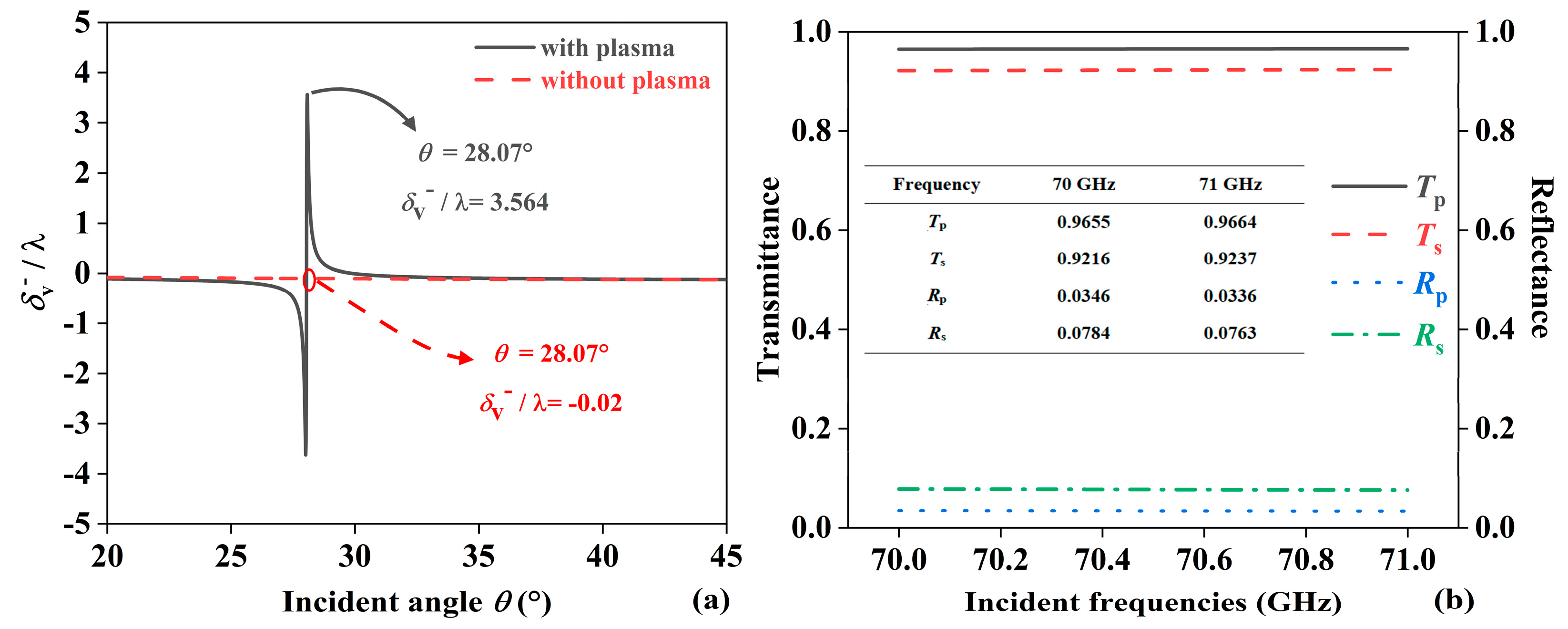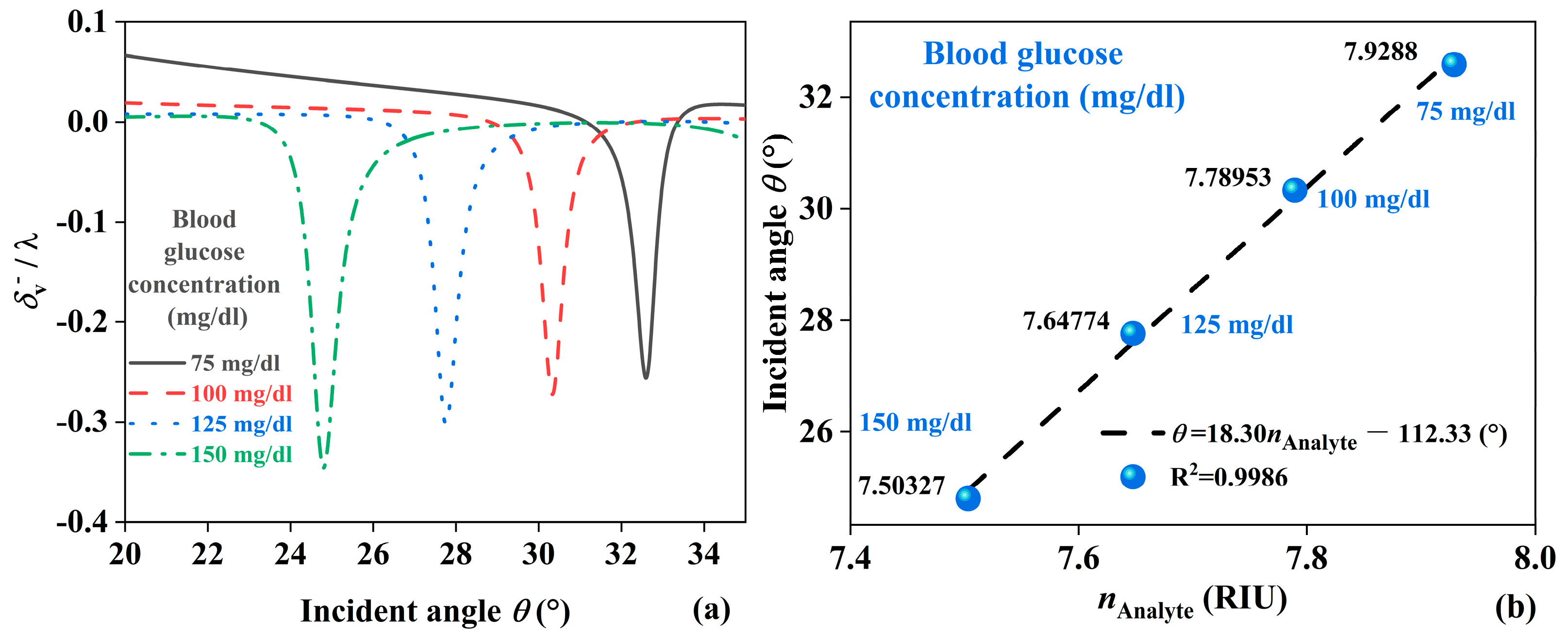High-Sensitivity Janus Sensor Enabled by Multilayered Metastructure Based on the Photonic Spin Hall Effect and Its Potential Applications in Bio-Sensing
Abstract
1. Introduction
2. Structure Design and Simulation
3. Results and Discussion
4. Conclusions
Author Contributions
Funding
Institutional Review Board Statement
Informed Consent Statement
Data Availability Statement
Conflicts of Interest
References
- Reichl, K.K.; Inman, D.J. Lumped Mass Model of a 1D Metastructure for Vibration Suppression with No Additional Mass. J. Sound Vib. 2017, 403, 75–89. [Google Scholar] [CrossRef]
- Moschovitis, C.G.; Karakatselos, K.T.; Papkelis, E.G.; Anastassiu, H.T.; Ouranos, I.C.; Tzoulis, A.; Frangos, P.V. Scattering of Electromagnetic Waves from a Rectangular Plate Using an Enhanced Stationary Phase Method Approximation. IEEE Trans. Antennas Propag. 2010, 58, 233–238. [Google Scholar] [CrossRef]
- Li, X.; Yang, C.; Guo, C.; Li, Q.; Peng, C.; Zhang, H. Temperature-Switch-Controlled Second Harmonic Mode Sensor for Brain-Tissue Detection. Sensors 2024, 24, 3065. [Google Scholar] [CrossRef] [PubMed]
- Zhu, B.; Feng, Y.; Zhao, J.; Huang, C.; Jiang, T. Switchable metamaterial reflector/absorber for different polarized electromagnetic waves. Appl. Phys. Lett. 2010, 97, 051906. [Google Scholar] [CrossRef]
- Zhang, J.; Ruan, Y.; Hu, Z.D.; Wu, J.; Wang, J. An enhanced high Q-factor resonance of quasi-bound states in the continuum with all-dielectric metasurface based on multilayer film structures. IEEE Sens. J. 2023, 23, 2070–2075. [Google Scholar] [CrossRef]
- Nair, R.V.; Vijaya, R. Photonic Crystal Sensors: An Overview. Prog. Quantum Electron. 2010, 34, 89–134. [Google Scholar] [CrossRef]
- Liu, Y.; Liu, W.-G.; Zhu, Y.-C.; Zhou, S.; Dai, Z.-H.; Sun, X.-P.; Ge, S.-B.; Guo, W.-H.; Wang, Z.-H. Propagation and Localization of Light in One-Dimensional Nonlinear Photonic Crystals Embedded Polyvinylidene Fluoride/Graphene Oxide Layers. Opt. Mater. 2024, 151, 115255. [Google Scholar] [CrossRef]
- Villanueva, J.L.M.; Huanca, D.R.; Oliveira, A.F. One-Dimensional Porous Silicon Photonic Crystals for Chemosensors: Geometrical Factors Influencing the Sensitivity. Sens. Actuators A Phys. 2023, 364, 114784. [Google Scholar] [CrossRef]
- Wu, F.; Lyu, K.; Hu, S.; Yao, M.; Xiao, S. Ultra-Large Omnidirectional Photonic Band Gaps in One-Dimensional Ternary Photonic Crystals Composed of Plasma, Dielectric and Hyperbolic Metamaterial. Opt. Mater. 2021, 111, 110680. [Google Scholar] [CrossRef]
- Zhang, X.; Kim, E.; Mark, D.K.; Choi, S.; Painter, O. A superconducting quantum simulator based on a photonic-bandgap metamaterial. Science 2023, 379, 6629. [Google Scholar] [CrossRef]
- Boyd, R.W.; Heebner, J.E. Sensitive disk resonator photonic biosensor. Appl. Opt. 2001, 40, 5742–5747. [Google Scholar] [CrossRef]
- Luan, E.; Shoman, H.; Ratner, D.M.; Cheung, K.C.; Chrostowski, L. Silicon photonic biosensors using label-free detection. Sensors 2018, 18, 3519. [Google Scholar] [CrossRef] [PubMed]
- Laplatine, L.; Luan, E.; Cheung, K.; Ratner, D.M.; Dattner, Y.; Chrostowski, L. System-level integration of active silicon photonic biosensors using Fan-Out Wafer-Level-Packaging for low cost and multiplexed point-of-care diagnostic testing. Sens. Actuators B Chem. 2018, 273, 1610–1617. [Google Scholar] [CrossRef]
- Blevins, M.G.; Fernandez-Galiana, A.; Hooper, M.J.; Boriskina, S.V. Roadmap on Universal Photonic Biosensors for Real-Time Detection of Emerging Pathogens. Photonics 2021, 8, 342. [Google Scholar] [CrossRef]
- Xu, Z.; Zhang, Q.; Li, X.; Huang, X. A critical review on chemical analysis of heavy metal complexes in water/wastewater and the mechanism of treatment methods. Chem. Eng. J. 2022, 429, 131688. [Google Scholar] [CrossRef]
- Khan, R.; Gul, B.; Khan, S.; Nisar, H.; Ahmad, I. Refractive index of biological tissues: Review, measurement techniques, and applications. Photodiagn. Photodyn. Ther. 2021, 33, 102192. [Google Scholar] [CrossRef]
- Almawgani, A.H.; Taya, S.A.; Daher, M.G.; Alhawari, A.R.; Colak, I.; Patel, S.K. Design of a novel protein sensor of high sensitivity using a defective ternary photonic crystal nanostructure. Silicon 2023, 15, 775–782. [Google Scholar] [CrossRef]
- Scullion, M.G.; Krauss, T.F.; Di Falco, A. Slotted photonic crystal sensors. Sensors 2013, 13, 3675–3710. [Google Scholar] [CrossRef] [PubMed]
- Haque, E.; Al Noman, A.; Ahmed, F. Numerical investigation of photonic crystal fiber-based biosensor for pathogens detection in water. IEEE Access 2022, 10, 88885–88893. [Google Scholar] [CrossRef]
- Andersson, G.; Ridings, C. Ion scattering studies of molecular structure at liquid surfaces with applications in industrial and biological systems. Chem. Rev. 2014, 114, 8361–8387. [Google Scholar] [CrossRef]
- Aly, A.H.; Zaky, Z.A. Ultra-Sensitive Photonic Crystal Cancer Cells Sensor with a High-Quality Factor. Cryogenics 2019, 104, 102991. [Google Scholar] [CrossRef]
- El-Aziz, O.A.A.; Elsayed, H.A.; Sayed, M.I. One-Dimensional Defective Photonic Crystals for the Sensing and Detection of Protein. Appl. Opt. 2019, 58, 8309–8315. [Google Scholar] [CrossRef] [PubMed]
- Paternò, G.M.; Moscardi, L.; Donini, S.; Ariodanti, D.; Kriegel, I.; Zani, M.; Parisini, E.; Scotognella, F.; Lanzani, G. Hybrid One-Dimensional Plasmonic–Photonic Crystals for Optical Detection of Bacterial Contaminants. J. Phys. Chem. Lett. 2019, 10, 4980–4986. [Google Scholar] [CrossRef] [PubMed]
- Bailey, R.C.; Parpia, M.; Hupp, J.T. Sensing via optical interference. Mater. Today 2005, 8, 46–52. [Google Scholar] [CrossRef]
- Rodriguez-Lorenzo, L.; Fabris, L.; Alvarez-Puebla, R.A. Multiplex optical sensing with surface-enhanced Raman scattering: A critical review. Anal. Chim. Acta 2012, 745, 10–23. [Google Scholar] [CrossRef]
- Blum, L.J.; Marquette, C.A. Chemiluminescence-based sensors. Opt. Chem. Sens. 2006, 224, 157. [Google Scholar]
- Barone, P.W.; Baik, S.; Heller, D.A.; Strano, M.S. Near-infrared optical sensors based on single-walled carbon nanotubes. Nat. Mater. 2005, 4, 86–92. [Google Scholar] [CrossRef]
- Sui, J.; Xu, J.; Liang, A.; Zou, J.; Wu, C.; Zhang, T.; Zhang, H. Multiple physical quantities Janus metastructure sensor based on PSHE. Sensors 2023, 23, 4747. [Google Scholar] [CrossRef]
- Liu, S.; Yin, X.; Zhao, H. Dual-function photonic spin Hall effect sensor for high-precision refractive index sensing and graphene layer detection. Opt. Express 2022, 30, 31925–31936. [Google Scholar] [CrossRef]
- Zhou, X.; Sheng, L.; Ling, X. Photonic spin Hall effect enabled refractive index sensor using weak measurements. Sci. Rep. 2018, 8, 1221. [Google Scholar] [CrossRef]
- Zhu, W.; Xu, H.; Pan, J.; Zhang, S.; Zheng, H.; Zhong, Y.; Yu, J.; Chen, Z. Black phosphorus terahertz sensing based on photonic spin Hall effect. Opt. Express 2020, 28, 25869–25878. [Google Scholar] [CrossRef] [PubMed]
- Sui, J.Y.; Zou, J.H.; Liao, S.Y.; Li, B.X.; Zhang, H.F. High sensitivity multiscale and multitasking terahertz Janus sensor based on photonic spin Hall effect. Appl. Phys. Lett. 2023, 122, 231105. [Google Scholar] [CrossRef]
- Luo, W.; Xiao, S.; He, Q.; Sun, S.; Zhou, L. Photonic spin Hall effect with nearly 100% efficiency. Adv. Opt. Mater. 2015, 3, 1102–1108. [Google Scholar] [CrossRef]
- Liu, Y.; Ke, Y.; Luo, H.; Wen, S. Photonic spin Hall effect in metasurfaces: A brief review. Nanophotonics 2017, 6, 51–70. [Google Scholar] [CrossRef]
- Hosten, O.; Kwiat, P. Observation of the spin Hall effect of light via weak measurements. Science 2008, 319, 787–790. [Google Scholar] [CrossRef]
- Kamenev, A.O.; Efimov, I.M.; Vanyushkin, N.A.; Gevorgyan, A.H. On the sensitivity of defect modes outside the first photonic bandgap in optical sensors based on defected 1D photonic crystals. Phys. Scr. 2024, 99, 045521. [Google Scholar] [CrossRef]
- Efimov, I.M.; Vanyushkin, N.A.; Gevorgyan, A.H. The Determination of the Sensitivity of Refractive Index Sensors. Photonics 2024, 11, 56. [Google Scholar] [CrossRef]
- Rakhshani, M.R.; Mansouri-Birjandi, M.A. High sensitivity plasmonic refractive index sensing and its application for human blood group identification. Sens. Actuators B Chem. 2017, 249, 168–176. [Google Scholar] [CrossRef]
- Yan, L.; Yang, X.; Zhang, Y.; Wu, Y.; Cheng, Z.; Darling, S.B.; Shao, L. Porous Janus materials with unique asymmetries and functionality. Mater. Today 2021, 51, 626–647. [Google Scholar] [CrossRef]
- Sui, J.Y.; Liao, S.Y.; Zou, J.H.; Chen, Q.; Tang, Z.; Li, X.; Yang, C.; Guo, C.M.; Wu, Y.R.; Dong, R.Y.; et al. Design and research of the Janus metastructure. Results Phys. 2024, 61, 107795. [Google Scholar] [CrossRef]
- Gangwar, R.K.; Pathak, A.K.; Kumar, S. Recent Progress in Photonic Crystal Devices and Their Applications: A Review. Photonics 2023, 10, 1199. [Google Scholar] [CrossRef]
- Cheng, J.; Xiang, Y.; Xu, J.; Liu, S.; Dong, P. Highly Sensitive Refractive Index Sensing Based on Photonic Spin Hall Effect and Its Application on Cancer Detection. IEEE Sens. J. 2022, 22, 12754–12760. [Google Scholar] [CrossRef]
- Schultz, P.C. Binary titania-silica glasses containing 10 to 20 wt% TiO2. J. Am. Ceram. Soc. 1976, 59, 214–219. [Google Scholar] [CrossRef]
- Wan, B.F.; Xu, Y.; Zhou, Z.W.; Zhang, D.; Zhang, H.F. Theoretical investigation of a sensor based on one-dimensional photonic crystals to measure four physical quantities. IEEE Sens. J. 2020, 21, 2846–2853. [Google Scholar] [CrossRef]
- Firdausi, A.; Hakim, G.P.; Kurniawan, F.A.; Septiyana, D.; Alaydrus, M. Development of a microstrip antenna for glucose detection at millimeter waves. In Proceedings of the 2019 IEEE Conference on Antenna Measurements & Applications (CAMA), Kuta, Indonesia, 23–25 October 2019; pp. 81–183. [Google Scholar]
- Vrba, J.; Vrba, D. A Microwave Metamaterial Inspired Sensorfor Non-Invasive Blood Glucose Monitoring. Radio Eng. 2015, 24, 877–884. [Google Scholar]
- Zou, X.J.; Zheng, G.G.; Chen, Y.Y. Confinement of Bloch surface waves in a graphene-based one-dimensional photonic crystal and sensing applications. Chin. Phys. B 2018, 27, 054102. [Google Scholar] [CrossRef]
- Saini, R.; Kumar, A.; Bhatt, G.; Kapoor, A.; Paliwal, A.; Tomar, M.; Gupta, V. Lossy mode resonance-based refractive index sensor for sucrose concentration measurement. IEEE Sens. J. 2019, 20, 1217–1222. [Google Scholar] [CrossRef]
- Ignatyeva, D.; Kapralov, P.; Golovko, P.; Shilina, P.; Khramova, A.; Sekatskii, S.; Nur-E-Alam, M.; Alameh, K.; Vasiliev, M.; Kalish, A.; et al. Sensing of Surface and Bulk Refractive Index Using Magnetophotonic Crystal with Hybrid Magneto-Optical Response. Sensors 2021, 21, 1984. [Google Scholar] [CrossRef]
- Thadson, K.; Sasivimolkul, S.; Suvarnaphaet, P.; Visitsattapongse, S.; Pechprasarn, S. Measurement precision enhancement of surface plasmon resonance based angular scanning detection using deep learning. Sci. Rep. 2022, 12, 2052. [Google Scholar] [CrossRef]
- Goyal, A.K.; Kumar, A.; Massoud, Y. Thermal Stability Analysis of Surface Wave Assisted Bio-Photonic Sensor. Photonics 2022, 9, 324. [Google Scholar] [CrossRef]
- Sahu, S.; Srivastava, T.; Jha, R. Plexcitonic system for high photonic spin Hall effect. Appl. Phys. Lett. 2023, 123, 203302. [Google Scholar] [CrossRef]







| Scale | Biosensing | JBS Performance of Detection | |
|---|---|---|---|
| Forward | None | Range (RIU) | 1.3~1.55 |
| Sensitivity (°/RIU) | 96.29 | ||
| Backward | Blood glucose concentration | Range (RIU) | 7.50327~7.9288 |
| Sensitivity (°/RIU) | 18.30 | ||
| RI (RIU) | Positioning Angle (°) | δv−/λ |
|---|---|---|
| 1.3341 | 31.5 | 4.854 |
| 1.35181 | 33.24 | 5.483 |
| 1.37038 | 35.03 | 6.261 |
| 1.38906 | 36.83 | 6.794 |
| 1.40713 | 38.55 | 7.747 |
| 1.42383 | 40.15 | 8.022 |
| Blood Glucose Concentration (mg/dL) | Relative Permitivity | Positioning Angle (°) | δv−/λ |
|---|---|---|---|
| 75 | 62.8658 | 32.59 | −0.2562 |
| 100 | 60.6768 | 30.33 | −0.2723 |
| 125 | 58.4879 | 27.76 | −0.3025 |
| 150 | 56.299 | 24.8 | −0.3457 |
| Refs. | Multi-Scale | Principle | Detection | Sensitivity |
|---|---|---|---|---|
| [47] | × | Bloch surface waves | RI: 1.33 ~1.34 RIU | 25.1°/RIU |
| [48] | × | Lossy mode resonance | RI: 1.33~1.45 RIU | 61.922°/RIU |
| [49] | × | Tamm state | RI: 1.333~1.33862 RIU | 21.89°/RIU |
| [50] | × | Surface plasmon resonance | RI | 53.96°/RIU |
| [51] | √ | Bloch Surface Wave | RI | 0.1046°/RIU |
| Temperature | −0.0027°/°C | |||
| [52] | × | PSHE | RI | 81°/RIU |
| JBS | √ | PSHE | RI: 1.3~1.55 RIU | 96.29°/RIU |
| Blood glucose concentration | 18.30°/RIU |
Disclaimer/Publisher’s Note: The statements, opinions and data contained in all publications are solely those of the individual author(s) and contributor(s) and not of MDPI and/or the editor(s). MDPI and/or the editor(s) disclaim responsibility for any injury to people or property resulting from any ideas, methods, instructions or products referred to in the content. |
© 2024 by the authors. Licensee MDPI, Basel, Switzerland. This article is an open access article distributed under the terms and conditions of the Creative Commons Attribution (CC BY) license (https://creativecommons.org/licenses/by/4.0/).
Share and Cite
Li, X.; Zhang, H. High-Sensitivity Janus Sensor Enabled by Multilayered Metastructure Based on the Photonic Spin Hall Effect and Its Potential Applications in Bio-Sensing. Sensors 2024, 24, 5796. https://doi.org/10.3390/s24175796
Li X, Zhang H. High-Sensitivity Janus Sensor Enabled by Multilayered Metastructure Based on the Photonic Spin Hall Effect and Its Potential Applications in Bio-Sensing. Sensors. 2024; 24(17):5796. https://doi.org/10.3390/s24175796
Chicago/Turabian StyleLi, Xiang, and Haifeng Zhang. 2024. "High-Sensitivity Janus Sensor Enabled by Multilayered Metastructure Based on the Photonic Spin Hall Effect and Its Potential Applications in Bio-Sensing" Sensors 24, no. 17: 5796. https://doi.org/10.3390/s24175796
APA StyleLi, X., & Zhang, H. (2024). High-Sensitivity Janus Sensor Enabled by Multilayered Metastructure Based on the Photonic Spin Hall Effect and Its Potential Applications in Bio-Sensing. Sensors, 24(17), 5796. https://doi.org/10.3390/s24175796









